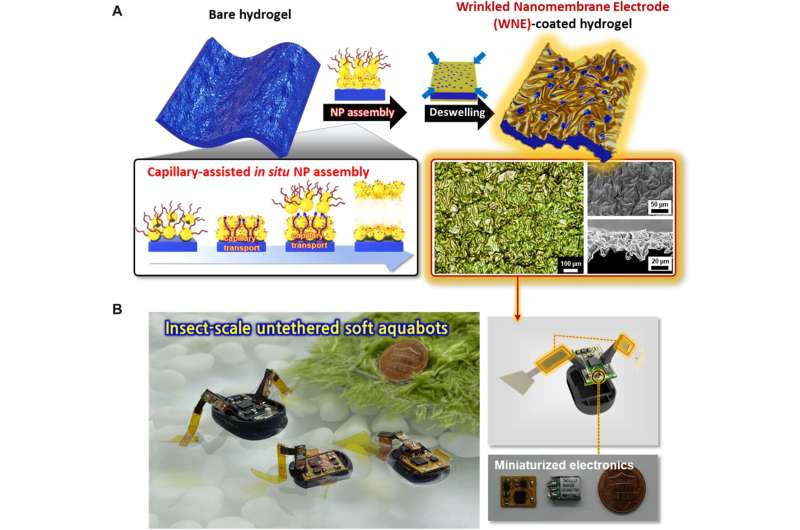Insect-scale untethered soft aquabots by WNE-coated hydrogel actuators. (A) Schematic illustration of the formation of WNEs prepared from capillary-assisted in situ NP assembly and deswelling processes with their consequent optical microscopy and SEM images. (B) Schematic illustration and photographic image of the representative untethered soft aquabots integrated with WNE-hydrogel actuator, circuit board, and battery. Credit: Science Robotics (2022). DOI: 10.1126/scirobotics.abo6463
A team of researchers from Korea University, Ajou University and Hanyang University, all in the Republic of Korea, has created a tiny aquabot propelled by fins made of a porous hydrogel imbued with nanoparticles. In their paper published in the journal Science Robotics, the group describes how the hydrogel works to power a tiny boat and reveals how much voltage was required.
Scientists and engineers have been working for several years to build tiny, soft robots for use in medical applications and have found that hydrogels are quite suitable for the task. Unfortunately, such materials also have undesirable characteristics, most notably, poor electro-connectivity. In this new effort, the researchers took a new approach to making hydrogels more amenable for use with electricity as a power source—adding conductive nanoparticles.
The work involved adding a small number of nanoparticles to a part of a porous hydrogel which they then used as a wrinkled nanomembrane electrode (WNE) actuator. Adding the nanoparticles allowed the hydrogel to conduct electricity in a reliable way. Testing showed the actuator could be powered with as little as 3 volts of electricity. The researchers then fashioned two of the actuators into finlike shapes and attached them to a tiny plastic body. Electronics added to the body controlled the electricity sent to the fins. The resulting robot had a water bug appearance, floating on the surface of the water in a tank.
Maneuvering of untethered soft aquabot. Credit: Ko et al., Sci. Robot. 7, eabo6463 (2022)
The actuator worked via electricity transmitted to the electrodes in the fins that were sandwiched in the hydrogel. This resulted in the creation of an electroosmotic water flow inside of a small part of the hydrogel, which in turn controlled the amount of swelling. As the hydrogel swelled, it changed the shape of the fin, resulting in a pushing force that moved the tiny aquabot on the surface of the water. The researchers note that the actuators had an energy density that was greater than 7 x 105 joules per cubic meter.
More information: Jongkuk Ko et al, High-performance electrified hydrogel actuators based on wrinkled nanomembrane electrodes for untethered insect-scale soft aquabots, Science Robotics (2022). DOI: 10.1126/scirobotics.abo6463
Journal information: Science Robotics
© 2022 Science X Network
























